The MGA With An Attitude
LAYGEAR with Substitute Needle Bearings #2 - GT-204D
On Feb 22, 2017, Ken Q in Appleton, Wisconsin, USA wrote:
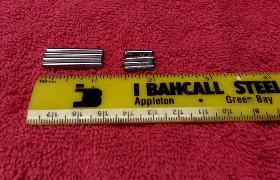 "I have upgraded the bearings by using the longer first motion shaft bearings (Moss 442-298). It requires shortening the spacer tube and modifying the hardened washers. If the gear ID bearing surface is machined and ground far enough from the end to accommodate the longer bearings; some gears are not. The bore does not need to be enlarged to accommodate the longer bearings because the rollers are of the same diameter.
"I have upgraded the bearings by using the longer first motion shaft bearings (Moss 442-298). It requires shortening the spacer tube and modifying the hardened washers. If the gear ID bearing surface is machined and ground far enough from the end to accommodate the longer bearings; some gears are not. The bore does not need to be enlarged to accommodate the longer bearings because the rollers are of the same diameter.
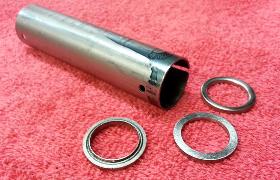
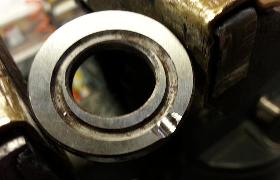
"The hardened thrust washers used with the original loose bearings need to be carefully ground to accommodate the ends of the new rollers. Shortening the spacer tube is tricky as well. I've found that I can do it accurately in the lathe with a cut-off wheel in my Dremel. The double set of loose bearings in the front are usually undamaged and can be reused".
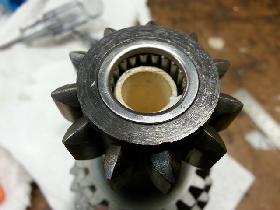
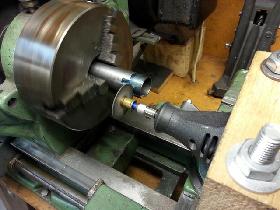 Apparently he has used the standard dual needle bearings in front, and modified the rear bearing only to use the longer rollers. The longer rollers are from the spigot bearing in the rear of the input gear, which carries the front end of the main shaft. These rollers are flat or slightly crowned on the ends (no spigot on the individual rollers). The idea is to re-use the end thrust plates from the original layshaft bearings, grind off the slightly protruding inboard pilot ridge to be flush to the face, and then shorten the tube spacer to allow for the longer rear bearing.
Apparently he has used the standard dual needle bearings in front, and modified the rear bearing only to use the longer rollers. The longer rollers are from the spigot bearing in the rear of the input gear, which carries the front end of the main shaft. These rollers are flat or slightly crowned on the ends (no spigot on the individual rollers). The idea is to re-use the end thrust plates from the original layshaft bearings, grind off the slightly protruding inboard pilot ridge to be flush to the face, and then shorten the tube spacer to allow for the longer rear bearing.
You should also check to verify there is enough space inside the rear of the laygear for the longer rollers. The original laygear is not finish bored all the way through. It is bored slightly undersize, then finish ground in both ends. When I tried to install two of the standard needle bearing assemblies in the rear of the laygear, the bore was not finished deep enough to accept the dual length bearings. I spent a LOT of time using a brake cylinder hone to open up the bore to accept the second bearing in the rear of the laygear. Otherwise you need to use a very sharp carbide cutting tool (or maybe an adjustable reamer) to finish the rear bore farther down in the gear. I believe the original laygear was made from 9310 steel, which is very tough and does not wear much, but could be difficult to machine.
|